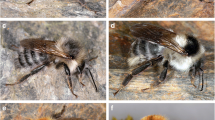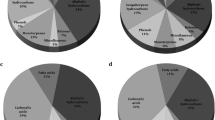Abstract
Males of the European and African beewolf,Philanthus triangulum, possess a sex specific mandibular gland secretion that is used for marking plant stems in mating territories. The secretion is composed of 90% (Z)-11-eicosen-1-ol plus small amounts of 10-nonadecen-2-one, nonadecenal, octadecanoic and octadecenoic acids, and eicosenal. The chemistry of this secretion differs markedly from the secretions of North AmericanPhilanthus, which consist of a larger number of components that possess different chemical functionalities and are more volatile. We postulate that the chemical differences betweenP. triangulum and its New World relatives reflect phylogenetic differences plus a possible reduced necessity for species isolating mechanisms inP. triangulum.
Similar content being viewed by others
References
Alcock, J. 1975. Territorial behaviour by males ofPhilanthus multimaculatus (Hymenoptera: Sphecidae) with a review of territoriality in male sphecids.Anim. Behav. 23:889–895.
Blum, M.S. 1981. Chemical Defenses of Arthropods. Academic Press, New York.
Borg-Karlson, A.-K., andTengö, J. 1980. Pyrazines as marking volatiles in Philanthine and Nyssonine wasps (Hymenoptera: Sphecidae).J. Chem. Ecol. 6:827–835.
Buser, H.-R., Arn, H., Guerin, P., andRauscher, S. 1983. Determination of double bond positions in mono-unsaturated acetates by mass spectrometry of dimethyl disulfide adducts. Anal. Chem. 55:818–822.
Dunkelblum, E., Tan, S.H., andSilk, P.J. 1985. Double-bond location in monounsaturated fatty acids by dimethyl disulfide derivatization and mass spectrometry: Application to analysis of fatty acids in pheromone glands of four Lepidoptera.J. Chem. Ecol. 11:265–277.
Evans, H.E. 1983. Nesting and territorial behavior ofPhilanthus barbatus Smith (Hymenoptera: Sphecidae).J. Kans. Entomol. Soc. 55:571–576.
Evans, H.E., andO'neill, K.M. 1988. The Natural History and Behavior of North American Beewolves. Comstock Publ., Ithaca, New York.
Francis, G.W., andVeland, K. 1981. Alkylthiolation for determination of double-bond positions in linear alkenes.J. Chromatogr. 219:379–384.
Free, J.B., Williams, I.H., Pickett, J.A., Ferguson, A.W., andMartin, A.P. 1982. Attractiveness of (Z)-11-eicosen-1-ol to foraging honeybees.J. Apic. Res. 21:151–156.
Guilford, T., Nicol, C., Rothschild, M., andMoore, B.P. 1987. The biological roles of pyrazines: Evidence for a warning odor.Biol. J. Linn. Soc. 31:113–128.
Gwynne, D.T. 1978. Male territoriality in the bumblebee wolf,Philanthus bicinctus (Mickel) (Hymenoptera, Sphecidae): Observations on the behaviour of individual males.Z. Tierpsychol. 47:89–103.
Jones, D., Bowyer, D.E., Gresham, G.A., andHoward, A.N. 1966. An improved spray reagent for detecting lipids on thin-layer chromatograms.J. Chromatogr. 23:172–174.
McDaniel, C.A., andHoward, R.W. 1985. Mass spectral determination of aldehydes, ketones, and carboxylic acids using 1,1-dimethylhydrazine.J. Chem. Ecol. 11:303–310.
McDaniel, C.A., Howard, R.W., O'Neill, K.M., andSchmidt, J.O. 1987. Chemistry of male mandibular gland secretions ofPhilanthus basilaris Cresson andPhilanthus bicinctus (Mickel) (Hymenoptera: Sphecidae).J. Chem. Ecol. 13:227–235.
O'Neill, K.M. 1979. Territorial behavior in males ofPhilanthus psyche (Hymenoptera, Sphecidae).Psyche 86:19–43.
O'Neill, K.M. 1983. Territoriality, body size, and spacing in males of the beewolfPhilanthus basilaris (Hymenoptera; Sphecidae).Behaviour 86:295–321.
Pickett, J.A., Williams, I.H., andMartin, A.P. 1982. (Z)-11-Eicosen-1-ol, an important new pheromonal component from the sting of the honeybee,Apis mellifera L. (Hymenoptera, Apidae).J. Chem. Ecol. 8:163–175.
Piek, T., andMantel, P. 1986. Cholinergic antagonists in a solitary wasp venom.Comp. Biochem. Physiol. 85C:433–436.
Rathmayer, W. 1962. Das Paralysierungsproblem beim Bienenwolf,Philanthus triangulum F. (Hym. Sphec.).Z. Vergl. Physiol. 45:413–462.
Schmidt, J.O., O'neill, K.M., Fales, H.M., McDaniel, C.A., andHoward, R.W. 1985. Volatiles from mandibular glands of male beewolves (Hymenoptera: Sphecidae,Philanthus) and their possible roles.J. Chem. Ecol. 11:895–901.
Scribe, P., Guezennec, J.D., Pepe, C., Saliot, A. 1988. Identification of the position and stereochemistry of the double bond in monounsaturated fatty acid methyl esters by gas chromatography/mass spectrometry of dimethyl disulfide derivatives.Anal. Chem. 60:928–931.
Simon Thomas, R.T., andPoorter, E.P.R. 1972. Notes on the behaviour of males ofPhilanthus triangulum (F.) (Hymenoptera, Sphecidae).Tijdschr. Entomol. 115:141–151.
Simon Thomas, R.T., andSimon Thomas, A.M.J. 1980.Philanthus triangulum and its recent eruption as a predator of honey bees in an Egyptian oasis.Bee World 61:97–107.
Tinbergen, N. 1972. Animal in its World: Explorations of a Ethologist, 1932–1972. Harvard University Press, Cambridge, Massachusetts.
Author information
Authors and Affiliations
Rights and permissions
About this article
Cite this article
Schmidt, J.O., McDaniel, C.A. & Simon Thomas, R.T. Chemistry of male mandibular gland secretions ofPhilanthus triangulum . J Chem Ecol 16, 2135–2143 (1990). https://doi.org/10.1007/BF01026925
Received:
Accepted:
Issue Date:
DOI: https://doi.org/10.1007/BF01026925




